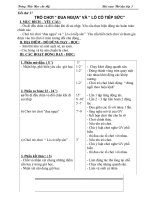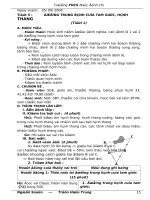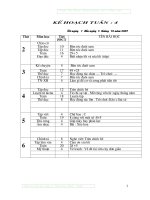- Trang chủ >>
- Mầm non - Tiểu học >>
- Lớp 5
5 6 2 the kudzu invasion
Bạn đang xem bản rút gọn của tài liệu. Xem và tải ngay bản đầy đủ của tài liệu tại đây (3.51 MB, 13 trang )
Suggested levels for Guided Reading, DRA,™
Lexile,® and Reading Recovery™ are provided
in the Pearson Scott Foresman Leveling Guide.
Life Science
The Kudzu
Invasion
by Lillian Forman
Genre
Expository
nonfiction
Comprehension
Skills and Strategy
• Main ideas and
Details
• Generalize
• Text Structure
Text Features
• Captions
• Glossary
Scott Foresman Reading Street 5.6.2
ISBN 0-328-13581-X
ì<(sk$m)=bdfibd< +^-Ä-U-Ä-U
Vocabulary
bleached
carcasses
decay
Reader Response
The
Kudzu Invasion
1. What is the main idea presented on pages 6–9? Use a
graphic organizer like the one below to note details
and write a sentence telling the main idea.
Detail:
Detail:
Detail:
parasites
scrawny
Main Idea:
starvation
suspicions
tundra
Word count: 1,438
2. Make an outline of the main ideas about kudzu
presented in this book. Notice how the author
presents information about kudzu. In general, does
the author present a positive or a negative view of
kudzu? Explain your answer.
by Lillian Forman
3. Using the dictionary, find the root of the word
habitat. Define the root. Make two other words using
that root.
4. If we were to get kudzu under control, do you think
people should be allowed to sell it and grow it, if they
are careful? Explain your answer.
Note: The total word count includes words in the running text and headings only.
Numerals and words in chapter titles, captions, labels, diagrams, charts, graphs,
sidebars, and extra features are not included.
Editorial Offices: Glenview, Illinois • Parsippany, New Jersey • New York, New York
Sales Offices: Needham, Massachusetts • Duluth, Georgia • Glenview, Illinois
Coppell, Texas • Ontario, California • Mesa, Arizona
You might not think that a plant can take over
part of a country, but one did. It’s called kudzu. In
1876, kudzu was brought to the United States for
the Centennial Exposition in Philadelphia. This event
celebrated the United States’ one-hundredth birthday.
Many people from other countries came to celebrate
and share things from their own countries. The
Japanese created a garden with some of their native
plants. One was a vine called kudzu. It was very pretty
with big green leaves and sweet-smelling flowers.
Kudzu has sweet-smelling flowers.
Every effort has been made to secure permission and provide appropriate credit for
photographic material. The publisher deeply regrets any omission and pledges to
correct errors called to its attention in subsequent editions.
Unless otherwise acknowledged, all photographs are the property of Scott Foresman,
a division of Pearson Education.
Photo locators denoted as follows: Top (T), Center (C), Bottom (B), Left (L), Right (R),
Background (Bkgd)
Opener ©Buddy Mays/Corbis; Opener (Inset)AP/Wide World Photos; 1 AP/Wide World
Photos; 3 ©Ray Coleman/Photo Researchers, Inc.; 4 AP/Wide World Photos; 7 ©Martin
B. Withers; Frank Lane Picture Agency/Corbis; 8 AP/Wide World Photos; 10 ©Buddy
Mays/Corbis; 12 ©Robert W. Ginn/PhotoEdit; 14 AP/Wide World Photos; 16 ©Margaret
Bourke-White/Time Life Pictures/Getty Images; 18 ©Steve Nudson/Alamy; 19 ©RoyaltyFree/Corbis; 20 ©Phil Schermeister/Corbis; 21 ©Lawrence Manning/Corbis
ISBN: 0-328-13581-X
Copyright © Pearson Education, Inc.
All Rights Reserved. Printed in China. This publication is protected by Copyright,
and permission should be obtained from the publisher prior to any prohibited
reproduction, storage in a retrieval system, or transmission in any form by any
means, electronic, mechanical, photocopying, recording, or likewise. For information
regarding permission(s), write to: Permissions Department, Scott Foresman, 1900 East
Lake Avenue, Glenview, Illinois 60025.
4 5 6 7 8 9 10 V0H3 14 13 12 11 10 09 08 07 06
3
Travelers have been transporting plants and
animals from one country to another for centuries.
Christopher Columbus and explorers who followed
him brought plants and animals from the Americas
to Europe and from Europe to the Americas. Most
of these transplants improved their new homes by
adding variety to the plant and animal life. These
plants also added to human culture. For example,
Italian cooks could never have created marinara
sauce for spaghetti without tomatoes from the
Americas.
American gardeners loved kudzu and began to
grow it. Southerners liked its thick leaves. They saw
it as a way to shade their porches during long, hot
days. The plant could take root in soil where nothing
else could grow. It did well in warm, humid weather.
It soon became common in the South.
Bringing plants from one country to another is
not always a good thing. The exotic plant may grow
so fast that it crowds out local plant life. Kudzu has
been doing this in the South. It has found a habitat
without insects or frost to kill it. During the summer,
kudzu can grow as much as a foot a day.
The kudzu plant grows and spreads quickly.
4
5
In the early 1900s, Charles and Lillie Pleas of
Florida discovered some of kudzu’s benefits. They
saw that it could prevent erosion. Its long roots
could grip and hold soil that might otherwise be
worn away by wind or flood. They also found that it
contained protein and vitamins A and D. This made
it good food for cattle. Eager to spread kudzu’s
benefits, the Pleases opened a nursery to sell the
plant.
During the late 1930s, a farmer named Channing
Cope became a supporter of kudzu. Cope had sevenhundred acres of eroded soil. After planting kudzu,
Cope’s once worthless acres were soon providing
nourishing feed for his livestock. Cope wrote
newspaper articles about this “miracle vine,” praised
it over the radio, and set up the Kudzu Club of
America. He announced to the public, “Cotton isn’t
king in the South anymore. Kudzu is king.”
Kudzu plants can prevent erosion.
6
7
Probably the only place kudzu couldn’t grow was
the Alaskan tundra. Cope and the Pleases did a lot
to make the kudzu popular, but no one did more to
promote kudzu than the U.S. government.
During the 1930s, floods and droughts were
ruining U.S. farmers. The topsoil they needed was
being washed and blown away. President
Franklin D. Roosevelt started a government service
to protect farmland from damage by flood and
drought. This service hired young men to build
levees, or embankments, to prevent rivers and dams
from flooding and to plant kudzu on riverbanks to
help keep them in place during heavy rainfalls.
The government also advertised the benefits of
kudzu and gave farmers eight dollars an acre to
plant it on their property.
In the early 1900s, a biologist named David
Fairchild had suspicions about kudzu. He warned
people that it might invade, spread, and damage
farms. The idea that a single plant could overrun
the environment was a new idea. Few scientists
supported his warnings.
Kudzu can cover almost
anything in its path.
8
9
By the mid-1990s, kudzu had taken over almost
11,000 square miles of the southern United States.
A scrawny kudzu plant can quickly develop into
many hardy plants. Every year it takes over another
120,000 acres. Its vines take over tree branches and
smother them like parasites. The trees become
lifeless carcasses. The kudzu has left more than seven
million acres of forest in a state of decay.
The plants and animals that live in these forests
lose their food and shelter. Without sunlight, the
plants growing on the forest floor fade to a bleached
green and die.
Other serious losses occur as well. The people in
damaged wilderness areas often lose their means
of making a living. When commercial forests are
destroyed, forest workers’ jobs vanish. Products
made from these forests become scarcer and more
expensive. If storeowners must import these products,
then the U.S. factories that once made them must
close, thus putting many more people out of work.
10
Kudzu has taken over forests.
11
Kudzu is so strong that it can
tear down power lines.
Kudzu even attacks human-made structures.
These vines can even pull down a farmhouse. Today,
farmers are forever trying to protect their houses
and barns from this killer plant. It is strong enough
to destroy power lines too. Power and telephone
companies spend a lot of money to repair the lines
that the kudzu has damaged.
Kudzu also causes other problems. It provides
nesting places for snakes. It grows over gullies and
ditches, turning them into booby traps for people
and livestock. Imagine falling through a dense
growth of kudzu into a swarm of snakes while on a
nature walk!
12
13
Southerners have found many ways to destroy
this harmful plant. These include mowing it, burning
it, poisoning it, and letting animals eat it.
Mowing can rid the land of kudzu. Before
mowing, a farmer should investigate to make sure
that the kudzu is not hiding ditches, logs, or wells.
Otherwise the tractor driver might be injured. Also,
kudzu is so tough that the mowers must have strong,
specially made blades.
14
Fire can also be an effective weapon against
kudzu. Even if the flames do not kill the kudzu, they
will clear away the vines and leaves. It is true that
fire causes kudzu seeds to sprout, but this can be an
advantage. The seedlings, no longer hidden by the
full-grown plants, can then either be poisoned or
burned again.
15
Poisoning is the fastest way to destroy kudzu.
This is very risky, though. Before using any poison, a
farmer must make sure that the kudzu is not covering
a drinking-water well or spring. Poisons can also
harm wildlife and prevent new crops from growing.
Conservationists prefer the grazing method of
destroying kudzu. It’s safer for the environment. If
farmers let their livestock graze on kudzu, the starch
in its roots will be used up in its efforts to repair
itself. The kudzu will then die of starvation.
Grazing is the safest way to destroy the kudzu plant.
16
17
People use kudzu as a barrier.
18
Most methods of destroying kudzu are gradual.
Southerners know they will have to put up with the
nuisance for a long time. Therefore, many of them
have found creative ways of coping with the weed.
Some people take advantage of its thick, rapid
growth. They make fences and other barriers out of
it. It also can provide a good way to hide things. A
U.S. soldier in the South Pacific during World War
II had to find a quick way to hide some antiaircraft
guns from enemy planes. Recognizing some kudzu
plants growing nearby, he remembered how quickly
the plant grew and how thoroughly it could hide
large objects. So he dug them up and replanted
them around the guns. In a few days, the guns had
completely disappeared from view.
19
Kudzu is a healthy food for animals. It can be
used for human food too. Chinese and Japanese
cooks grind up its roots to make a thickener for
sauces and soups. They also steam its leaves for
vegetable dishes or dry and powder them to make
dough. In the United States, health food stores sell
a variety of kudzu food products. Southern cooks
make jelly and tea from its flowers.
Asians also use kudzu as a medicine. They make
starch cakes and brew tea from its roots. They claim
that these products can cure headaches, muscle
stiffness, stuffy noses, and other sicknesses.
Kudzu’s
strong fibers
have many
uses.
The kudzu’s vine stem is also useful. The core of
the stem has fibers that can be woven into colorful
paper, wallpaper, and fishnets. The elastic young
vines can also be made into baskets. The whole
plant is ground up to make pulp for cardboard and
other paper products. People who want to protect
the environment approve of this practice because it
lessens the need to cut down trees.
It is important to stop kudzu and other invasive
plants from coming into our country. We cannot survive
without a healthy environment. A healthy environment
depends on a good mixture of plants and animals.
Sadly, many exotic plants and animals are taking over
large areas of the United States. They are harmful to
the ecosystem. They add little or no benefits to the
ecosystem and use up all of its resources.
20
21
Glossary
Vocabulary
bleached
bleached
adj. having
become paler or whiter
than
before.
carcasses
carcasses n. dead bodies.
decay
decay n. the process of
rotting.
parasites
parasites n. living things
that feed off of other
scrawny
living
things.
Reader Response
scrawny adj. very thin;
bony.
starvation n. death from
lack of food.
suspicions n. doubts.
1. What is the main idea presented on pages 6–9? Use a
graphic organizer like the one below to note details
and write a sentence telling the main idea.
Detail:
Detail:
Detail:
tundra n. a vast, level,
treeless plain in the arctic
regions.
Main Idea:
starvation
suspicions
tundra
Word count: 1,438
2. Make an outline of the main ideas about kudzu
presented in this book. Notice how the author
presents information about kudzu. In general, does
the author present a positive or a negative view of
kudzu? Explain your answer.
3. Using the dictionary, find the root of the word
habitat. Define the root. Make two other words using
that root.
4. If we were to get kudzu under control, do you think
people should be allowed to sell it and grow it, if they
are careful? Explain your answer.
Note: The total word count includes words in the running text and headings only.
Numerals and words in chapter titles, captions, labels, diagrams, charts, graphs,
sidebars, and extra features are not included.
22









